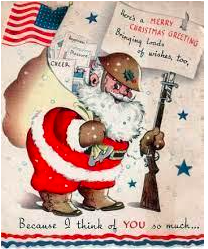
The holiday season has begun, and it is a time for us to be grateful and to reflect on Christmases past. How did WWII affect the way Americans celebrated Christmas during those difficult years when so many service members were away from home?
On September 16, 1940, President Roosevelt signed the Selective Training & Service Act, the first peacetime draft in U.S. history. This took effect on October 1st, so by Christmas 1940 a small number of young men were already away from home at military training camps. The following December found us at war after the Japanese attacked Pearl Harbor on December 7th. But Christmas was not to be denied. Food for the holiday feast, gift items, and toys for the children were still available and holiday lights still brightened the mood. At the White House, FDR requested the National Christmas Tree be placed on the South Lawn and the tree lighting ceremony was made even more memorable by the presents of British Prime Minister Winston Churchill, who traveled to Washington DC to confer with the President after the bombing of Pearl Harbor. Sadly, after 1941 the National Tree would remain dark for the remainder of the war. Black-out orders were enacted, especially on the west coast, and Americans’ holiday wish that year (and for several years to come) was for the end of the war.
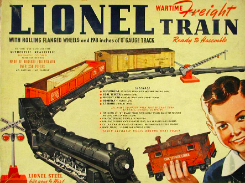 As the war years trudged on the availability of food items for the traditional feast, as well as gift items, were scarce due to rationing and the fact that many companies changed over to war production. Children’s toys were limited as toy companies converted to making war materials, and the metals, rubber, and other materials used in toy production were now needed for the war effort. Paper dolls, puzzles, and games became popular thanks to the availability of paper and cardboard. Hobby kits with a military and war motifs were also on children’s wish lists. Lionel Corporation, famous for its trains, produced a Wartime Freight Train made entirely of heavy-duty paper stock.
As the war years trudged on the availability of food items for the traditional feast, as well as gift items, were scarce due to rationing and the fact that many companies changed over to war production. Children’s toys were limited as toy companies converted to making war materials, and the metals, rubber, and other materials used in toy production were now needed for the war effort. Paper dolls, puzzles, and games became popular thanks to the availability of paper and cardboard. Hobby kits with a military and war motifs were also on children’s wish lists. Lionel Corporation, famous for its trains, produced a Wartime Freight Train made entirely of heavy-duty paper stock.
Note: Ad includes “No War materials were used”
Families who had loved ones in service needed to begin holiday preparations early as cards and packages had to be mailed between September 15 – October 15th to hopefully be delivered to service men and women stationed overseas by Christmas. Families sent candy and cookies, made more precious due to the rationing of sugar and other ingredients, as well as warm socks, often knitted by hand after a long day of work in factories or other essential jobs, which were now filled by millions of women.
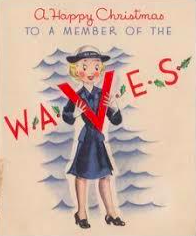 Hallmark, whose slogan was “Keep ’em happy with mail,” offered cards specifically for servicemen and women in each branch of the military, or featured Santa dressed as a soldier. For loved ones serving overseas, the importance of mail and holiday packages from home was second only to food. These reminders of home were important for American servicemen and women’s morale, and many a treasured card or gift item was carried throughout the war.
Hallmark, whose slogan was “Keep ’em happy with mail,” offered cards specifically for servicemen and women in each branch of the military, or featured Santa dressed as a soldier. For loved ones serving overseas, the importance of mail and holiday packages from home was second only to food. These reminders of home were important for American servicemen and women’s morale, and many a treasured card or gift item was carried throughout the war.
On the home front, in order to help inexperienced postal clerks sort mail, postal zones were established in 1943. Families prayed that a precious letter would arrive, especially this time of year, delivering holiday cheer with word that their loved ones were well and hoping to be home for Christmas next year.
With VE Day on May 8, 1945 and VJ Day of August 14, 1945, WWII was finally over. Then the task began to get the millions of service members home. In September 1945, the military launched “Operation Magic Carpet,” a special effort to get as many military personnel home as quickly as possible. As this effort continued through the Fall of 1945 it was renamed “Operation Santa Claus” with an all-out effort to use every available plane, train, and ship to get the servicemen and women home for Christmas.
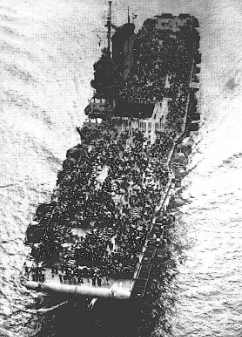
The crowded flight deck of the USS Saratoga. This ship transported home a total of 29,204 servicemen – more than any other vessel.
As soldiers, sailors, and other personnel arrived to the west coast separation centers to be processed and relieved of duty, the train and road traffic was so ensnarled that the National Guard was called out to direct traffic. The GI’s who were not-quite-home for Christmas still celebrated and were overjoyed to be on U.S. soil again. Many recalled how strangers gladly sacrificed to help returning vets.
Many shared stories of people giving up their seats or tickets to get the vets home, or delivering food and gifts to vets delayed at train stations across the county. Veterans’ stories of drivers helping them get home for Christmas include a trucker from Colorado who loaded a “human cargo” of thirty-five vets in his truck and drove across country to deliver the vets to each of their homes in the Midwest. Others recalled a Los Angeles cab driver who drove six returning vets to their homes in Chicago – some 2700 miles. Neither driver would accept money beyond the cost of fuel.
Christmas 1945 became the most celebrated Christmas in U.S. history. For the first time in years people felt free to decorate. Black-out curtains were removed, and brightly lit trees glowed in homes, town squares, and on the South Lawn of the White House.
Sadly, as we look back at Christmas 1945, it is important to recall that this holiday was not joyous for all Americans. That grief was shared in this editorial that appeared in a Schuylkill County, PA newspaper:
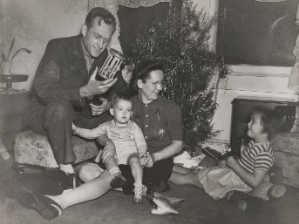
Soldier and his family, Christmas 1945 Photo courtesy of Wikimedia Commons
CHRISTMAS, 1945
How much more meaning for most of us is contained in the customary greeting, “Merry Christmas,” this year than twelve months ago! How fortunate we Americans are this year! It might be well to reflect upon this for a passing moment because we are, indeed, a lucky nation.
Unlike last year, we are not worried about any crucial battles. Our land is at peace and so is the greater part of the world this year. Fighting is going on only at several isolated points on the globe and they are mere skirmishes.
But there is plenty of misery throughout the world, particularly in Europe. There is intense suffering there. Oppression exists in more than one country. We talk of shortages of this and that but stop for a minute and think of the acute dearth of things necessary to life that exist at this very minute in many other countries.
Yes, this land has been blessed and we should show our thanks to the All High for making this possible. “Peace on earth, good will to men” really has a meaning this year for the first time in some years, and we sincerely trust nothing will come up during 1946 to change the picture.
There are many families right in our own area, of course, to whom Christmas will not mean much this year. There are empty chairs that will never be filled. The battles of last year took their toll of many a gallant lad from this section. There are families who have lost loved ones within the past several days and there is sickness in other homes to detract from the usual spirit of the Yuletide. All of these things go with life. To those folks, we hope next Christmas will be better. But, on the whole, most of us will greet tomorrow with more happiness and less worry than we have since December 7, 1941.
There will be real joy in the families with veterans back in civilian life once more. There will be children overjoyed with their fathers home again. Thoughts of this make us feel good, although our hearts go out to the veterans still in lands of occupation; particularly to those stranded due to transportation difficulties, only a few hundred miles from home. So to all concerned we extend the annual greeting, “A Merry Christmas to all,” and offer the timely reminder that we should remember the full significance of tomorrow, the birthday of Our Saviour, and what it stands for.
